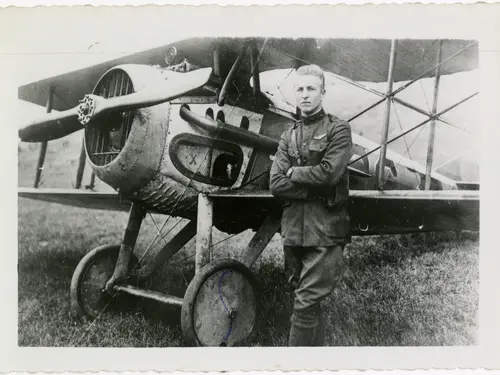The fast and rugged Spad XIII was among the most successful fighters of the First World War , in a class with the legendary Fokker D.VII and Sopwith Camel. It was flown by some of the most famous air heroes of the war, such as Guynemer, Fonck, Nungesser, Lufbery, Luke, and Rickenbacker.
The original Spad aircraft manufacturing company was formed by Armand Deperdussin in 1910. The acronym Spad was derived from the company's formal name, Société pour les Appareils Deperdussin. Spad was taken over in 1914 by the famous aviation pioneer, Louis Blériot, when the firm was experiencing serious financial difficulties. Blériot renamed the company Société pour l'Aviation et ses Dérives, thus retaining the same acronym.
Louis Béchereau, a talented designer who stayed with Spad after the reorganization of the company, was responsible for the successful series of Spad fighters in World War I. In 1915, he recognized the design limits of the then popular air-cooled, rotary engines that powered most French aircraft. A fixed, water-cooled engine, capable of generating at least 150 horsepower, was in his view the power plant of the future. At this time, just such an engine was undergoing trials. It was a new Hispano-Suiza V-8, designed by that company's founder and chief designer, a Swiss-born engineer named Marc Birkigt. The engine was a great step forward in that it had a much better power-to-weight ratio than previous water-cooled designs, as well as many other modern features. The new Hispano-Suiza engine was just what Béchereau was calling for. He designed his next airframe around the advanced Hispano-Suiza motor; the result was the famous Spad VII. By the fall of 1916, Spad VIIs were entering French squadrons and were well received. More than five-and-a-half thousand Spad VIIs were built.
The Spad XIII was a larger, improved version of the earlier Spad VII with, among other improvements, two fixed, forward-firing Vickers machine guns and a more powerful 200-horsepower Hispano-Suiza 8Ba engine. (Later Spad XIIIs had 220- and 235-horsepower Hispano-Suiza V-8 engines.) The prototype Spad XIII made its first flight on April 4, 1917, and by the end of the following month, production aircraft were arriving at the front. The aircraft was particularly noted for its robust construction and its ability to dive at high speed, features that made it one of the best dog-fighting airplanes of the war.
The Spad XIII was produced and deployed in great numbers. By the end of 1918, the parent company and eight other French manufactures had built 8,472 of the sturdy fighters. Almost every French fighter squadron was equipped with them by the end of the war, as well as the American units that were part of the American Expeditionary Force. Spads were also used by the British, the Italians, the Belgians, and the Russians. At the conclusion of hostilities, contracts for an additional 10,000 Spads, 6,000 of which were to be produced for the United States, were cancelled.
Surprisingly, given the large number built, only four Spad XIIIs remain. The one in the NASM collection, nicknamed Smith IV, was assigned to Lt. A. Raymond Brooks, U.S. Army Air Service, who named it after the college attended by his sweetheart and future wife. It was the fourth of his airplanes so named, hence Smith IV.
The Ray Brooks Spad XIII was built by the Kellner et Ses Fils piano works in August 1918. It was delivered to Colombey-les-Belles in September 1918 and assigned to the 22nd Aero Squadron, U.S. Army Air Service, where it was given the number "20" and assigned to Brooks. The aircraft was a replacement for another of the same type in which Brooks had earlier crashed. Brooks achieved one of his six personal aerial victories in Smith IV. Five other victories were scored with Smith IV while flown by other pilots.
After the war, Major Robert L. Walsh, a member of General William Mitchell's staff, proposed the idea of sending two Spad XIIIs to the United States, one of which was Smith IV. The airplane toured the country as part of Liberty Bond drives. It was then transferred to the Smithsonian Institution by the U.S. Air Service in December 1919.
For many years the NASM Spad XIII was displayed at the Smithsonian. Time eventually took its toll and by the 1980s Smith IV's fabric was rotting and tattered, its tires missing, and the airplane was in a general state of disrepair. In 1984-1986, it was fully restored and placed back on public display in the museum's First World War aviation gallery.








